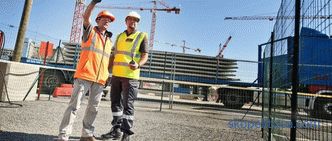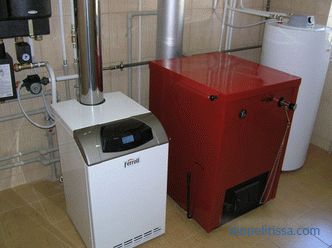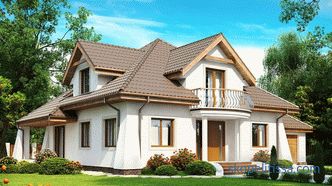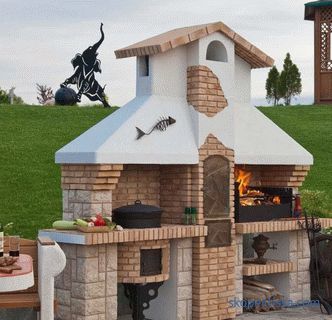The huge variety of building materials that are used today for decorating walls is often confused. Therefore, in this article I would like to talk about plaster coat - quite a popular way of finishing wall surfaces. That is, let us see what this plaster solution is, why this finishing is so called, its advantages and disadvantages, and also consider the method of application.
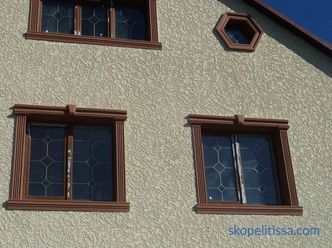
What is the finishing "fur coat"
Its name The technology of decorating the walls was obtained only because after applying the plaster mortar a coating is formed on the wall surface that resembles the back side of a sheepskin coat. That is the fur side. In this case, even a common cement-sand mortar can be used to form a coat. It's all about the method of its application. And this method is the usual sprinkling or spreading of the mixture, which forms a rough coating on the wall.
Of course, today no one uses traditional methods with the preparation of mortar from cement and sand with the addition of pigments. Manufacturers of dry plaster mixes offer a fairly large range of solutions "coat" with different color content.
The finishing process itself comes down to purchasing a finished dry mix, to diluting it with water in the proportions recommended by the manufacturer. With the subsequent drawing on the wall of the house. Manufacturers have gone further, so the market can be purchased "fur coat" in finished diluted form. This is a ready-made composition that you just need to put on the wall plane. And if the dry mixes are sold in paper bags, then ready diluted - in plastic buckets.
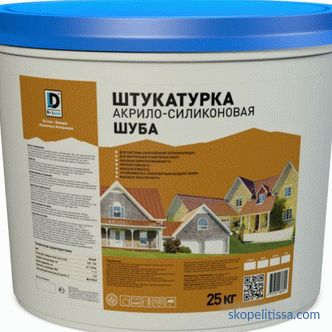
It should be added that the stucco in buckets is the material to which polymers are added. That is why this version of the plaster is applied to the walls without cracks and other flaws that usually appear after the drying of the finish. The fact is that polymers increase the plasticity of cement mortar.
Next, we’ll tell you how to properly carry out the finishing of this type.
Technology of applying plaster fur coat
First of all, as it usually happens with wall decoration, it is necessary to prepare the latter. First, check the surface for the difference of the plane.
-
If a small drop , not more than 0.5 mm per 1 m² of the finished area, then you can apply the plaster without beacons .
-
If the drop is 0.5-10 mm, then it is better to finish at the beacons . Or use a mixture , in which stone fractions of large size are added, for example, within 10 mm.
-
If the differential exceeds 10 mm, then the optimal solution is to first align the wall surface, and only then apply a fur coat.
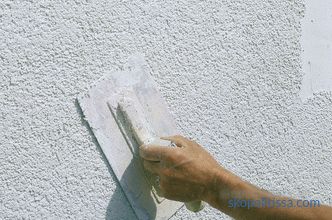
So, to prepare the wall to the application of plaster, it must first be examined for defects. This mainly concerns areas where the leveling layer has peeled off. Next, they usually carry out tapping of the wall in order to find voids under the plaster. This is done with a mallet or a wooden hammer handle. If there was a dull sound, then there is emptiness. In these areas, the leveling layer must be removed by any means and methods. After which it is filled with repair composition.
The next stage is the priming of the wall surface. Optimally - use a deep penetration primer for this. It penetrates inside the wall, polymerizing and turning the material into a durable layer. This increases the adhesive properties of the surface.
So, everything is ready, you can apply a fur coat. It is a lot of options of drawing. At the very beginning even used brooms. Later, a special hand-held apparatus appeared, which the masters immediately dubbed the "barrel organ". But this is all in the past. Today they use the pneumatic method, which requires a compressor and a special pistol called a cartouche.
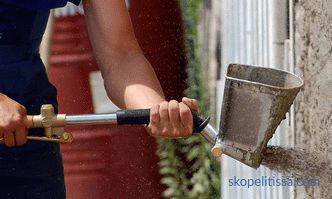
The main task of the manufacturer is to keep the pistol at a certain distance from the wall surface. The gap is selected taking into account the air pressure and the diameter of the nozzle of the gun. Here the main thing - uniform application of the solution. It is clear that it is impossible to make the maximum even coating, therefore irregularities are subsequently rubbed over with an ordinary metal spatula.
And another important addition. If the finished wall has a very smooth surface, then it is necessary to attach a plaster grid to it.
The video shows how the master applies a coat of plaster to the wall surface using an air gun:
On our site you can read the most popular projects of wooden and stone houses from the best construction companies with an impeccable reputation in the market. The site offers a free order calculation of the project. Directly to communicate with representatives, you can visit the exhibition of houses "Low-rise Country".
Useful Tips
In order for the facade of a fur coat to serve for a long time without changing its original appearance, it is necessary to adhere to some recommendations given by experienced craftsmen when applying it to the facade of a building.
-
The optimum temperature condition is , at which it is recommended to apply a coat of plaster: + 5С - + 27С.
-
It is impossible to allow that direct sunlight fell on a wet decorative coating. There will be a quick drying of the material, which will start to crack .
-
Not it is worth to carry out finishing work in rainy weather .
-
A coat is usually applied to three layers. You cannot allow a preliminary layer to completely dry before applying the next one. But it cannot be applied to the newly laid material either. It is necessary to find the golden mean .
-
A primer must be applied to the plaster . But it should dry well before applying the decorative layer .
-
Accurately follow instructions from the manufacturer in the process of mixing a dry solution with water. If you add a lot of water, the material will become liquid and will slide off the wall. If the water is low, the solution will become dense, it will be difficult to work with it.
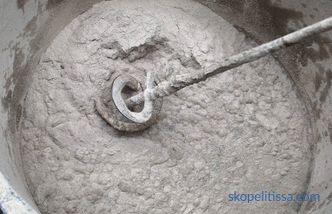
On our site you can find contacts construction companies that offer the service of turnkey design and construction of country houses, as well as an audit of construction works, internal redevelopment. Directly to communicate with representatives, you can visit the exhibition of houses "Low-rise Country".
Advantages and disadvantages of plaster "fur coat"
So, having understood the finishing of the house with a fur coat, we turn to the designation of its advantages and disadvantages.
-
This decorative coating easily tolerates severe temperature drops and humidity , which means it is excellent protection facade of the house from the negative impact of natural loads.
-
The plaster applied to the wall can be painted with any exterior paints, giving the wall a certain color shade. Many manufacturers offer finished material and dry mixes, in which pigments have already been added. It remains only to choose the desired color. Plaster of this variety can be repainted several times. The main thing is to apply facade paint in two layers.
-
At first glance, applying a plaster mortar is a simple process . So it is, if this is done by professionals.
-
The design of the surface of the facade walls can be modified. To do this, add granular ingredients to the solution, for example, stone chips fine fractions. There are many options and they are used by masters.
-
The plaster layer applied to the wall has a small mass. That is, fur coat on walls and the foundation of loads does not create .
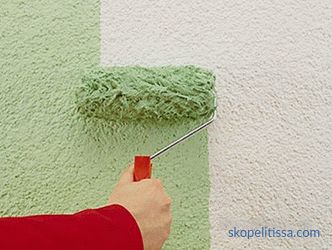
This can be interesting! In the article on the following link, read about the classification of decorative stones for exterior home decoration, the nuances of the cladding technology.
Now for the flaws.
-
Fur - decorative covering belonging to the category relief or textured . So, this is an avid dust collector.
-
It cannot be said that plastering with a fur coat is a universal coating in terms of decorative filling. This plaster mortar combines not with all building materials. So it will have to pick up. And it is better if it is done by a professional designer .
-
As for the heat-insulating qualities of the plaster, they are very low because it is primarily a cement mortar. Therefore, it is not necessary to count on this decorative layer in terms of increasing the insulation of the house.
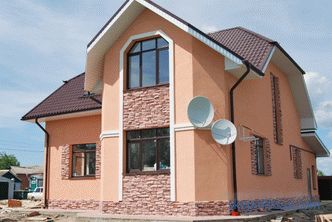
I would like to add that the appearance fur coats on the market made a special furor in due time. It became immediately popular because it was very different in decoration from what it was before.In addition, the low price and speed of work added its advantages. Today, when the market is simply flooded with others, even somewhere more advanced finishing materials, the fur coat has lost its position. But statistics inexorably shows that this plaster material is still being acquired. Moreover, manufacturers offer ready-to-use mortar, which simplifies the process of decorating facades with this material.
It might be interesting! In the article on the following link, read about how to properly finish the facade with a clinker tile.
Conclusion on the topic
So, a fur coat is a very interesting finishing material that covers the facades of buildings and structures. But the most interesting thing is that your expectations will be fully met when the house is finished with this material. The main thing is to choose the right color content so that it fits into the overall architecture of the building and is in harmony with other building materials.
Rate this article, we tried for you
